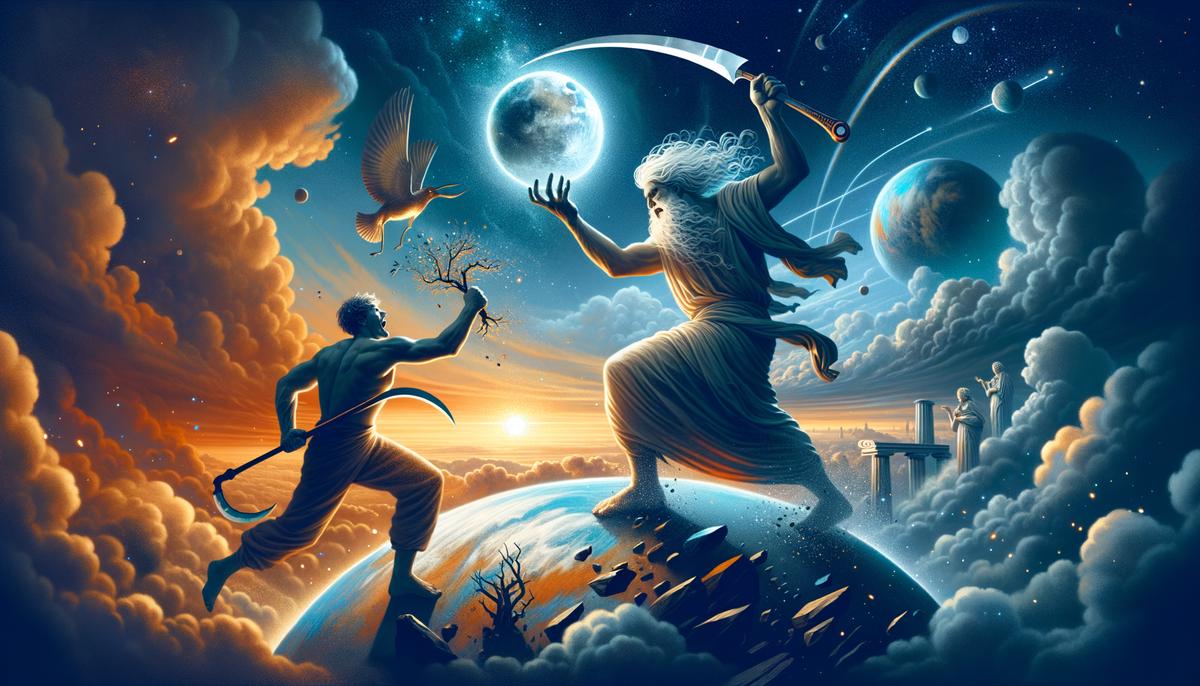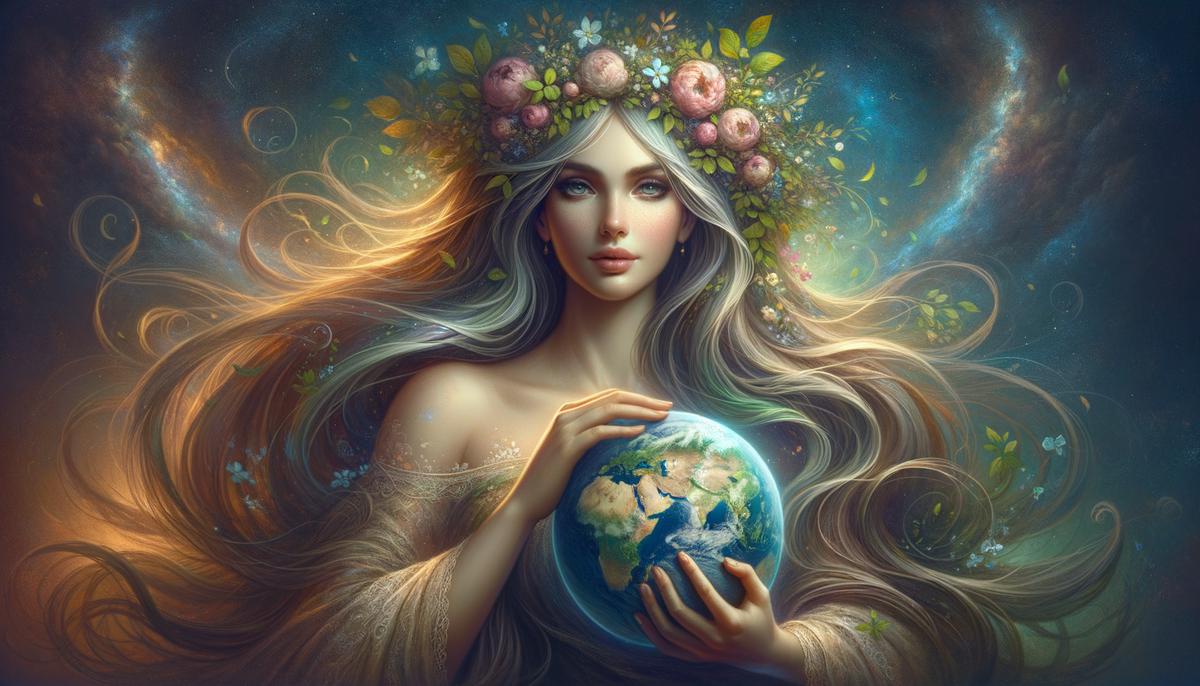Gaia's Origins and Family
Gaia, the great matriarch of Greek mythology, sprang from Chaos, the vast void before order existed. As the personification of the Earth, she represented the solid foundation on which all things rest—an emblem of stability and nurturing. Her identity laid the groundwork for myriad mythical narratives with Gaia at the heart of creation.
Gaia bore prominent children with Uranus (the Sky) and Pontus (the Sea). Her union with Uranus led to the birth of the Titans, including Cronus and Rhea, alongside the Cyclopes and the Hecatoncheires (hundred-handed giants). These beings were crucial to Gaia's story and foundational in the larger scope of Olympian drama.
The saga between Gaia and Uranus epitomizes the theme of strife between generations, a recurring motif in Greek mythology. Disillusioned with Uranus's tyrannical rule, where he imprisoned many of their children, Gaia orchestrated a revolt. Cronus, influenced by Gaia's frustrations, mutilated Uranus, leading to cascading events that shaped divine ancestries and enmities.
Gaia's story conveys broader truths about existence—her reactions reflect the Earth's life-giving yet formidable nature. Her alliances and conflicts introduced concepts such as revenge, betrayal, and resilience that mirrored human experiences.
With Pontus, Gaia continued expanding the family of deities. Their offspring included entities like Nereus and Thaumas, hinting at Gaia's dominion over land and sea. Bridging the divine with the terrestrial, her lore permeates almost every mythic narrative as the original progenitor.
As a maternal figure, Gaia's reputation leaned towards both creator and destroyer—her narrative contrasts fertility with a relentless pursuit of balance and justice. Her numerous children signify her role in procreation and suggest an interconnected web symbolizing environmental and metaphysical elements that sustain the universe.
Gaia illuminates the intertwined destinies of the Greek deities, forever enshrining her as a central figure in explaining worldly and divine phenomena. Her story reminds us of the cyclic nature of life and conflict, underscoring her portrayal as a versatile goddess who continually shapes her progeny's fates and, by extension, the cosmos' order.
Mythological Tales Involving Gaia
Gaia's role in mythological tales often speaks of creation, upheaval, and the initiation of radical changes, laying the groundwork for the dramatic evolution of the cosmos and its further descendants. Her gripping history of rebellion invites us to look into mythologies where she is the central figure around which the wheel of mythology turns.
Let's start with Gaia's ambitious maneuver against her spouse Uranus. Their marriage was fruitful yet marred by turmoil. Uranus feared that his children might topple him and shoved them back into Gaia's womb. Distressed yet determined, Gaia plotted with her son Cronus, providing him with a sickle.
Cronus assaulted Uranus, and from this severance came freedom for the oppressed siblings and the birth of new entities, including the Furies and giants. These emergent figures added layers to Gaia's persona embodying creation sprouting from even the direst situations.
Gaia's epic sagas continued during the rule of Cronus, who began devouring his own children to keep his throne secure. Once again appalled, Gaia switched her alliance to her grandson Zeus. She hid him safely away until he could mature and challenge Cronus. Her nurturing instincts paired with a focused antagonism towards injustice spearheaded the mythological trope of a younger generation set to challenge the outdated order.
Even after Zeus established himself, Gaia perceived his rule as another stretch of despotic dominion. Her displeasure bore Typhoeus, a monstrous entity aimed to dethrone Zeus. Though ultimately defeated, Gaia's efforts encapsulate her unwavering mission: driving transformative shifts towards improved balances in power.
Gaia emerges as an emblematic conveyor of Earth's raw and primal force striving toward balance. Each narrative showcases her usurping chaos to recalibrate order—through clear-cut ironies, dramatic paybacks, or catalytic role shifts in divine reigns. Romantic yet paradoxically critical of her creations, her renderings allegorize recurring human struggles between tradition and reform, oppression and resistance.
Gaia's manifold narratives are more than ancient bedtime stories; they are poignant reminders of change's pendulum, swinging perpetually, powered by the innate quests for evolution and equivalence, just as nature itself promises cyclical reckonings and renewals. As mother, maker, and mover of Earthly fates, Gaia leads these cosmic tales by nurturing as fiercely as she dismantles, always weaving her characters through an unfading, earthy wisdom.

Gaia's Worship and Cultural Significance
While Gaia's towering persona stood at the custodial watchtower in mythology, her influence wove through the fabric of ancient Greek society as well. This consecrated Earth-mother earned her respect through heartfelt offerings of fertility, nurture, and providence.
Temples to Gaia peppered the Greek landscape, serving as spiritual centers where humans invoked her blessings. At Olympia, rituals tributing Gaia often used natural objects such as ash or loose earth instead of elaborate embellishments for her altars—a humbling precedent in sustainable worship practices.
Ritualistic observance went beyond traditional spaces. In Athens, every newborn was dedicated to Gaia through private sacrifices before familial ceremonies. Her touch was a requisite in family dynamics, scripting seasonal renewals.
The oracle worship positioned Gaia as a blend between an earth-born seer and a rustic advisor. Her original role as a Delphic oracle negotiator and counselor rendered her akin to a spiritual consultant. Before Apollo took over these oracle duties, seeking sage advice from Gaia remained a favored societal pastime.
More practically, this universal matriarchal figure nurtured a culture deeply aligned with respect for the earth. Genuine, labor-intensive respect manifested in how plowing, seeding, and reaping cycles became synchronized to Gaia's harmony. Well-tended fields and fed families rated high on ancient satisfaction indices—echoing Gaia's themes of giving, sustaining, and cyclically enriching.
In these respites resides the essence of Gaia's elemental nature: a guardian unyieldingly grounded to both her cultivated lands and her mortal followers. Fathoming her prominence goes beyond the purchase of her mythos—each societal rite evolves a testimony to Gaia's engrossing effect, shaping history's tapestry into a targeted portrayal of life advancing, an adventurous tale underscored by earthy signatures courting cyclic eternities.

Gaia in Modern Context
Resurrecting ancient deities and repurposing them for modern movements isn't a novel concept, but few have donned as impactful a modern avatar as Gaia. In today's eco-conscious zeitgeist, she's transcended mere revival; Gaia has become an exemplar of environmental ethos and sustainability. The nurturer of yore galvanized into the nurturer of necessity, her name aiding as both a rallying cry and a soothing balm for our ecological crises.
First off, there's the audacious Gaia Hypothesis, conjured up by British scientist James Lovelock and microbiologist Lynn Margulis in the 1970s. This hypothesis proposed that Earth functions like a living organism—a self-regulating entity dabbing balance across the biosphere. Here, every organism plays a part in maintaining the health of the planet, much like cells work in synchrony inside your body.
Turning this scientific metaphor into a poetic parallel isn't far-fetched; it's deeply resonant. In Lovelock's vision, Gaia is the composer and the conductor, intricately guiding the systematic symphony—half bacteria, half biometrics. If trees exhale oxygen courtesy of Gaia's choreography, we mortals inhale per courtesy. The Earth isn't just Home Sweet Home; it's a Living Lab, Habitat Edition.
Moving from labs to faith, Gaia's modern homage isn't secularly scientific alone. She's had quite the ceremonial comeback in neopagan circles. Drawing folks nurturing a pro-Earth spirituality, contemporary paganism has enshrined her as Mother Earth—a dimensional render beyond fertility alone. She embodies the quintessential spirit of life-giving, weaving nature into nurture with threads of reverence and ritual. Across the globe are gatherings where festivals burn bright, recitations of Her ancient myths encore in harmonic echoes, empowering a network of believers bonded by reverence for Earth's all-giving biome.
For environmentalists seeking symbolism that stokes purpose and swings belief into urgent action, Gaia serves as the arch-matriarch rallying behind Earth's chorus, cheering for renewables over unwieldy fossils. The narrative is hardly lofty when rallies sing to save rainforests or to nourish fertile soils. Gaia morphs from Protogenoi parable into ecological paragon; from arm-length deity to embraced mascot draping organic market tees.
This renewed reach-out to Gaia isn't mystical rebranding; it's reconnecting with root metaphors—shared histories spun into integrated futures. Environmental conversations puzzling her tales thus vault beyond reminiscing—they ask urgent gazes toward resilience and symbiosis. Propelling dialogues on climate action and sustaining habitats can resonate deeper dipped in the essence of Gaia—turning passion into action, finding lessons from an arcadian legend cloaked in vibrant green.
Thus exists Gaia in the renewed sniff of modern contexts—an eternal maternal knitting nurture into nature, storytelling through the verdant dialect of survivals unfathomed yet striven for, here unveiled as constants immemorial now marshaled afresh—a sanctuary saga continually reblossoming.

In the grand tapestry of mythology and modernity, Gaia stands as a testament to the enduring power of nature and the necessity of balance. Her narratives, rich with conflict and resolution, remind us that the cycles of life and nature are perpetual, urging us to reflect on our role within this dynamic equilibrium.
- Leeming DA. Creation Myths of the World: An Encyclopedia. 2nd ed. ABC-CLIO; 2010.
- Hesiod. Theogony. Translated by Most GW. Loeb Classical Library 57. Harvard University Press; 2018.
- Graves R. The Greek Myths. Penguin Books; 1992.
- Lovelock J. Gaia: A New Look at Life on Earth. Oxford University Press; 2016.
- Rountree K. Contemporary Pagan and Native Faith Movements in Europe: Colonialist and Nationalist Impulses. Berghahn Books; 2015.

Leave a Reply